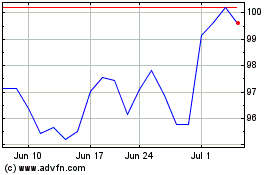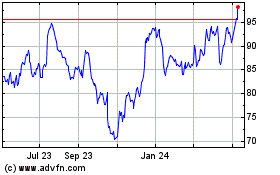By Liz Hoffman and Peter Rudegeair
Quarterly profit fell 10% at Morgan Stanley, the last of the big
U.S. banks to report earnings in a mixed quarter where trading
slowed and Main Street banks carried the day.
The bank reported a profit of $2.2 billion, or $1.23 a share, on
$10.24 billion in revenue, both down from a year ago, when it
earned $2.4 billion on $10.6 billion in revenue. Analysts polled by
FactSet had expected a profit of $1.9 billion, or $1.13 a share, on
$10 billion in revenue.
Morgan Stanley, the smallest of the major American banks, is the
last to report earnings in a tough quarter for high finance. Global
trade tensions quieted securities trading and a decline in
longer-term interest rates, spurred by the Federal Reserve's recent
shift to possibly lower rates, caused some corporate borrowers to
pull back.
Instead, consumer businesses drove higher profits at JPMorgan
Chase & Co., Citigroup Inc., Wells Fargo & Co. and Bank of
America Corp. Morgan Stanley has one of the world's largest retail
brokerages but lacks the big mortgage and credit-card operations
that helped rivals in the quarter.
At Morgan Stanley, cost control and some gains on principal
investments -- money invested for its own account into
private-investment deals -- helped paper over weakness in the
firm's trading and investment banking arms.
The bank's return on equity, a measure of profitability, was
11.2% in the quarter. Other banks ranged from 10% at Citigroup to
16% at JPMorgan.
Chief Executive James Gorman has steered Morgan Stanley into
steadier businesses since the financial crisis, doubling down on
wealth and asset management and cutting back on riskier kinds of
trading. Earlier this year Morgan Stanley bought a software firm
that helps corporate employees manage their finances, and plans to
build out Morgan Stanley's retirement-account offerings.
The firm kept a lid on expenses, down 3% so far this year, and
was particularly tight in allocating bonuses for its bankers and
traders, whose total accrued compensation for the year so far is
just 35% of the revenue they have made.
The wealth division, which manages about $2.5 trillion for U.S.
clients, reported $4.41 billion in quarterly revenue, up 2% from a
year earlier.
The rising stock market boosts the value of client portfolios,
on about half of which, some $1.1 trillion, Morgan Stanley clips a
steady management fees.
Trading revenue was down from a year ago. Fees from stock
trading, where Morgan Stanley is Wall Street's biggest, fell 14% to
$2.13 billion. Meanwhile, revenue was down 18% in fixed-income
trading, where Morgan Stanley is smaller than peers after firing a
quarter of the staff in 2016 and trimming assets.
So far that decision has been a good one. Low interest rates and
tighter credit spreads have hurt Wall Street fixed-income trading
desks, whose collective revenues are down 22% since 2013, according
to data provider Coalition. Stock trading has its own challenges,
like an expensive technology arms race, but commissions have held
up better.
Morgan Stanley posted a 13% decline in investment banking
revenue, compared with high-single-digit declines at other banks.
Morgan Stanley is a big merger adviser and stock underwriter,
landing roles on the second quarter's debuts of Uber Technologies
Inc. and Slack Technologies Inc.
There were 8% fewer completed M&A deals in the quarter,
collectively worth nearly 50% less, compared with a year earlier,
according to FactSet. And while a flood of highly anticipated
technology companies went public this spring, issuance of secondary
shares and convertible bonds has been slower than in 2018.
The biggest quarterly gains were in Morgan Stanley's
asset-management arm, where revenue grew 21% but remains a small
contributor to the firm's overall results. Growing that business,
which manages just under $500 billion, is a priority for Mr.
Gorman, who has hinted he would like to do a deal.
Morgan Stanley's total deposits grew 2% to $177 billion while
loans grew 4% to $258 billion, led by growth in mortgages to
clients of its wealth-management division. Morgan Stanley has been
rebooting its home-lending operation, which was for years a
problematic and small business that it outsourced to an external
company. In 2017 it brought the effort in-house and is now pricing
its loans more competitively.
The move is part of the firm's push into plain-vanilla banking,
to get at what it estimates is $2 trillion that its individual
clients keep at other banks. A decade after converting into a bank
holding company during the financial crisis, Morgan Stanley still
doesn't issue its own credit cards, write many mortgages or offer
competitive savings and checking accounts.
Unlike rival Goldman Sachs Group Inc., which has hung out a
shingle online and partnered with third parties such as Fidelity
Investments and Apple Inc. to find customers, Morgan Stanley is
aiming to become the primary bank to its existing 3.5 million
brokerage clients, who it estimates keep $2 trillion at other
financial institutions. Mr. Gorman recently tasked Shelley
O'Connor, a veteran of the firm's brokerage field operation, with
growing its consumer-banking business.
Write to Liz Hoffman at liz.hoffman@wsj.com and Peter Rudegeair
at Peter.Rudegeair@wsj.com
(END) Dow Jones Newswires
July 18, 2019 08:49 ET (12:49 GMT)
Copyright (c) 2019 Dow Jones & Company, Inc.
Morgan Stanley (NYSE:MS)
Historical Stock Chart
From Mar 2024 to Apr 2024

Morgan Stanley (NYSE:MS)
Historical Stock Chart
From Apr 2023 to Apr 2024
